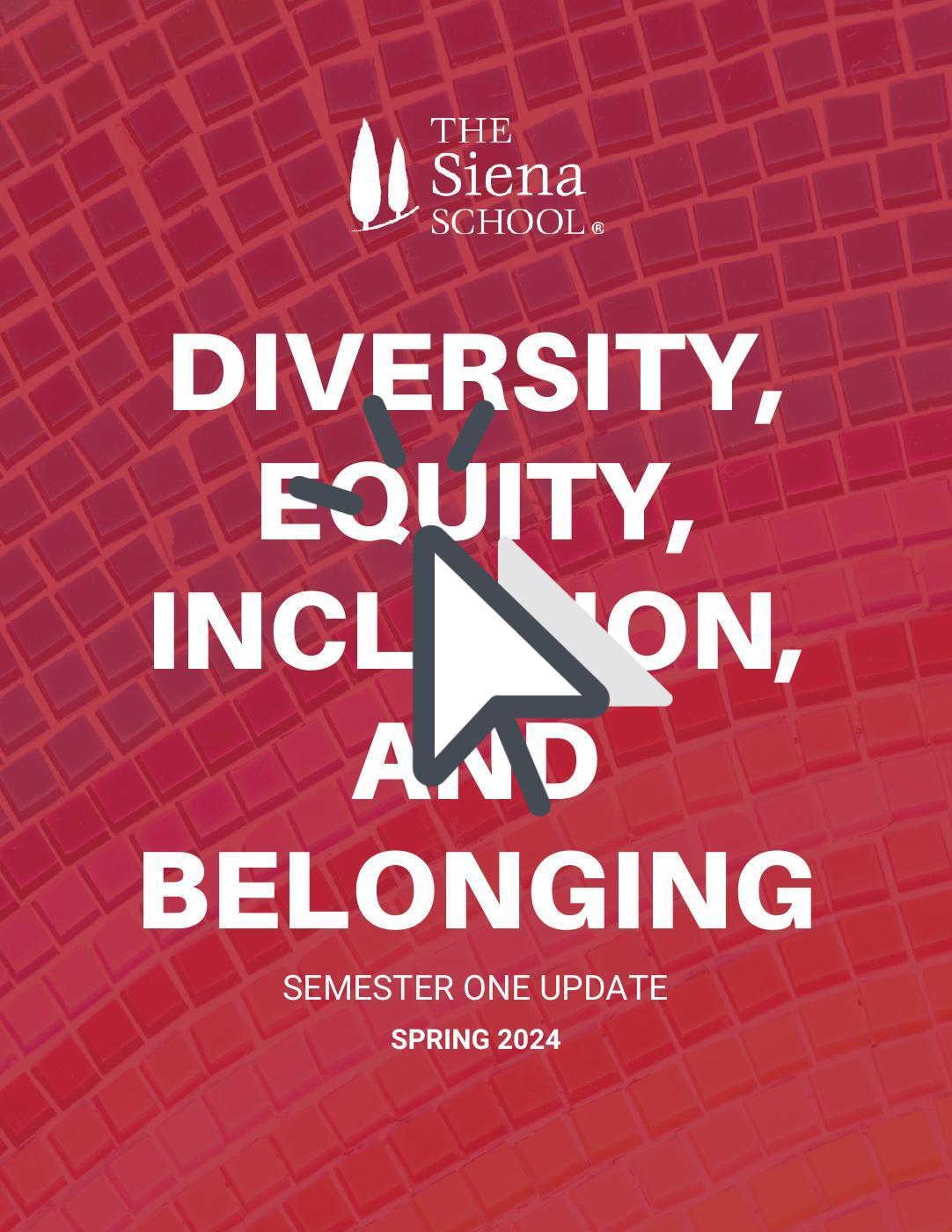Empowering students with language-based learning differences

Siena Blog



The Siena School Blog
Discover, Learn, Celebrate, and Empower
Welcome to Siena's blog, your source for helpful, cutting-edge resources tailored to teachers, parents, and other advocates in the learning differences community. We are dedicated to providing a wealth of curated knowledge spanning various topics, ranging from dyslexia advocacy and awareness to classroom teaching strategies, heritage month profiles, and social and emotional health.
Summer Boredom Busters
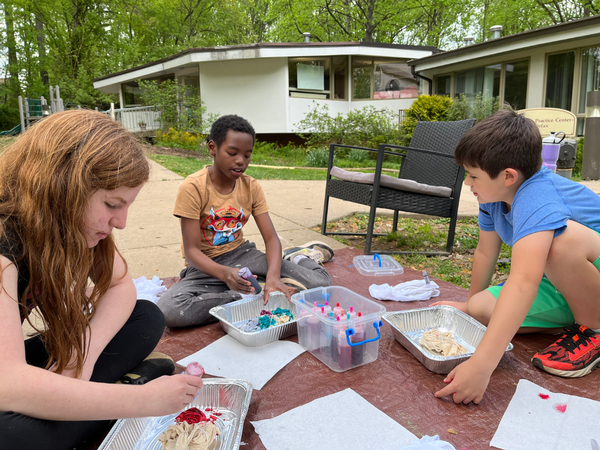
Fun Summer Activities for Students
Another summer is here, and parents might be looking for good activities to both engage their children and give a little bit of structure to the days and weeks ahead.
Ideal summer activities for school-age children often entail movement, creativity, and interactivity; they might also be multisensory and tactile to further engage children’s brains and alleviate boredom.
Scheduling some regular activities has the dual benefit of keeping children active and giving their summer days some structure. Many studies have shown the benefits of structure for children, especially those with ADHD. ADDitude has some good resources for daily schedules for parents and children to adapt for the summer.
Ideas for Indoor Activities
- Take a trip to your local library and get a bunch of books—mix in some old favorites with new ones to keep children reading
- Pick a book or two to write or imagine a prequel, sequel, or other extension of the story as a creative exercise
- Take on some Lego challenges inspired by Lego Masters builds (see also their Lego YouTube Channel)
- Make fidgets from Lego or other materials (these can also help with focus and anxiety management throughout the year)
- Try some fun DIY crafts, repurposing, and upcycling of various materials around the house
- Enjoy some age-appropriate baking or cooking projects and turn your kitchen into a Mini Master Chef
- Have a family dinner and a movie marathon—maybe with food from your Mini Master Chef kitchen
- Try some at-home science experiments, such as these suggestions from Good Housekeeping, Tinybeans, and SplashLearn
- Make slime or homemade play dough
- Create some DIY board games, paper airplanes, musical instruments, and more
- Design a puzzle scavenger hunt with clues to find certain pieces—parents and children can even take turns!
Ideas for Outdoor Activities
- Let children practice outdoor art with some sidewalk chalk, finger painting, fence painting, or tie-dyeing
- Plan a backyard camping night
- Cool off and engage the senses with outdoor water fun
- Experiment with some backyard science—see Steam Powered Family and Childhood 101 for good ideas
- Have children design a DIY scavenger hunt or obstacle course to exercise their creativity and their bodies
- Make (or expand) a backyard garden
- Build a birdhouse or bird feeder and keep a list of which kinds of birds visit
- Take regular walks and create nature collages based on what children see and find
Whether they’re happening indoors, outdoors, or in both places, hands-on activities like these provide opportunities for creativity, imagination, and exploration. They not only keep kids occupied but also allow them to develop various skills while having a great time with their families and/or friends.
Resources for Fun Summer Activities
See these resources for additional activities and ideas to keep school-age children engaged this summer:
- Ann Dolin of Educational Connections recently shared this post with 10 Writing Activities for Kids This Summer, which includes suggestions for elementary, middle, and high school ages.
- 100 Summer Fun Ideas for Kids and Parents (Very Well Family)
- 24 Low-Cost Summer Activities for Kids (Parents)
- 20 New Ideas and Activities to Try This Summer (PBS KIDS for Parents)
- Get Ready for Summer! Ideas for Teachers to Share with Families (Reading Rockets)
Last summer, Siena’s blog featured pieces on summer reading ideas for elementary, middle, and high school ages and tech skills to practice over summer break.
The Siena School proudly serves students with dyslexia and other language-based learning differences in grades 3-12 on campuses in Silver Spring, Maryland, and Oakton, Virginia.
Summer Reading at Siena
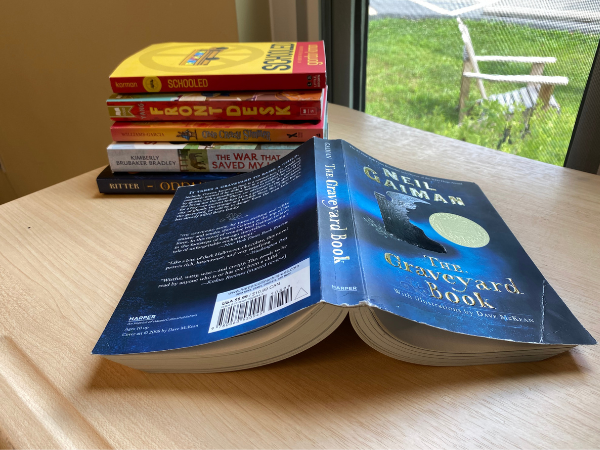
Benefits of Summer Reading
Summer reading is important for students’ academic and social-emotional development, but how can they find age-appropriate books that are also interesting and relatable to their experiences?
As this 2021 post from Scholastic points out, “Summer reading is critical, not only for helping kids maintain learning while school is out, but also for fostering social–emotional development, discovering the joy of stories, and elevating the importance of lifelong learning.”
Summer reading—even 15-20 minutes a day—helps students with dyslexia and other language-based learning differences: it will keep their reading, retention, and decoding skills sharp in preparation for the coming school year. Regular reading also helps students’ social–emotional skills by sharpening their awareness of the world, as well as increasing their empathy and ability to understand various points of view.
Getting students to read over the summer can be a challenge. But knowing what their peers have read and enjoyed can help, especially when students have diverse stories, characters, identities, and genres to choose from.
Summer Reading Recommendations for Teens and Tweens
At the end of the school year, Siena teachers shared summer reading packets, which included recommendations and class readings for students across all grade levels. Teachers typically assemble their own reading lists to share with students, and they always choose a variety of books that reflect Siena’s diverse community and curriculum. Here are some of the books Siena’s students have been reading this summer:

To further help students and parents, Siena Humanities chair and middle school English teacher Beth Fabijanic shared that the Young Adult Library Services Association (a division of ALA) offers ample recommendations for teen/tween readers, including:
- Quick Picks for Reluctant Young Adult Readers
- Best Fiction for Young Adults
- Great Graphic Novels for Teens
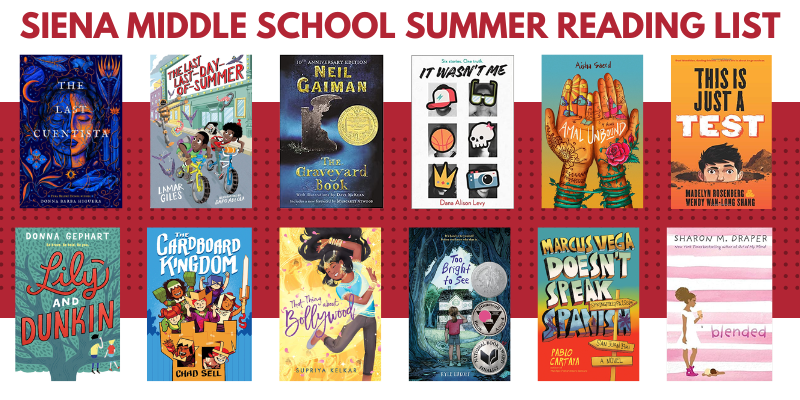
Students who prefer to listen to books—or who perhaps want to read along while listening—should also explore the audiobook selections on Amazing Audiobooks for Young Adults, Learning Ally, Audible, and Audiobook Sync (which updates free audiobooks for teens every week).
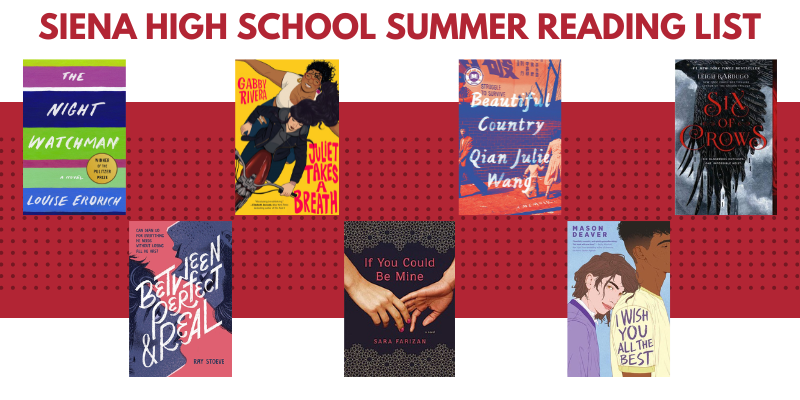
Resources for Summer Reading
“Children often react very differently when a parent or teacher tells them to do something compared to when they make a decision on their own,” this Dyslexia Resource post from 2020 observes. “When age-appropriate, encourage growing readers to develop their independence by allowing them to create their own summer reading schedule. While beginner readers should read around 20 minutes each day, leave the rest up to your student.”
Choosing their own daily reading time can give students a sense of control over the process, while the routine of summer reading can prepare them for the more structured days of the school year.
Here are some additional resources to help students with summer reading:
- Education consultant Ann Dolin recently wrote about engaging reluctant readers over the summer, including a handful of recommendations for different ages and suggestions for reading as a family.
- Fairfax County Public Library Teen Events and Resources and Montgomery County Public Library For Teens offer recommendations, events, programs, and more. Check public libraries in your area for similar summer reading services for young people.
- The National Education Association offers ample resources, activity ideas, and links for students to Get Serious About Summer Reading.
- The New York Public Library’s Staff Picks for Teen Readers goes back to Spring 2019 and lists English- and Spanish-language books.
Siena’s blog has more helpful resources for summer, including how students can improve their technology skills over the summer and how summer academics and camps can be beneficial.
2 Important Tech Skills Students Can Improve Over the Summer
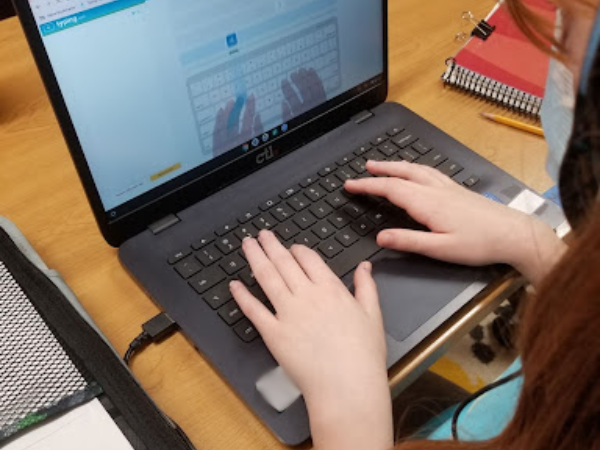
As students are reviewing their summer packets or doing other academic work, the summer is also a great time to reinforce tech skills. This needn’t be too complex or time-consuming: brushing up on students' tech skills can be an easy and fun part of their weekly summer routines.
Technology at Siena is integrated into the curriculum across all divisions and subjects. Students routinely use laptops, assistive technology, and a host of multimedia apps in classes to enhance their learning and equip themselves with 21st-century skills.
Likewise, summer tech work can be integrated into students’ other academic and social activities. Here are two key tech skills that students can easily learn—or improve—this summer while they’re getting some well-earned downtime after a long school year:
Touch Typing Skills
Touch typing is an important way for students to get their ideas onto paper (or a screen). As opposed to the hunt-and-peck approach of using their index fingers, touch typing can teach students to type via muscle memory so they can focus less on the how of expressing their ideas—and more on the ideas behind their writing.
For students with dyslexia and other language-based learning differences, touch typing is a multisensory approach that complements the assistive technology they might already be familiar with—such as Speech to Text—and helps develop a skill they can use throughout their time in and out of school.
Parents looking for ways their children can improve their typing skills this summer can look into Typing.com, which we use at Siena during the school year. There are also free apps that don't require an account to use, like TypingClub, as well as apps like Nitro Type that let students hone their skills by competing against other users through interactive, visual, and gamified learning.
As this Read and Spell blog post shares, “For dyslexic students, learning touch typing emphasizes spelling and phonics. Repeatedly encountering high frequency words also helps with training learners to recognize words by sight, which saves them from the decoding process that causes trouble in reading.”
Regardless of which typing app they use, students can hone their skills by practicing regularly each week of the summer.
Designing Basic Games
K-12 educators are increasingly using games and other interactive content in their classrooms, such as Kahoot! quizzes, WordFlight, and Prodigy. This 2021 article from Edutopia emphasizes games’ educational benefits, such as to “increase student participation, foster social and emotional learning, and motivate students to take risks.”
“It’s important to recognize the educational value of interactive games such as Minecraft,” adds Siena Director of Technology Simon Kanter, “insofar as they can develop students’ reasoning, problem solving skills, and social skills.”
Students who enjoy learning through games during the school year might enjoy spending some time over the summer creating their own through a platform such as Scratch. Originally developed at MIT, Scratch is a free service that lets students recreate classic games on their own while increasing their digital fluency and computational thinking. Siena students have used Scratch during the annual Hour of Code and during weekly Coding Club.
As Scratch’s website notes, “The ability to code computer programs is an important part of literacy in today’s society. When people learn to code in Scratch, they learn important strategies for solving problems, designing projects, and communicating ideas.” (See here for information and FAQs for parents about Scratch.)

Coupled with regular work on touch typing, learning basic coding and game design through Scratch over the summer can help students sharpen their tech skills to prepare them for next school year.
Resources for Summer Technology
See Siena’s blog for more posts about having a rejuvenating and productive summer, including ones on the benefits of summer tutoring and on summer camps and academic programs.
For additional ideas, you could also look at this guide (primarily for older students) from the University of Toronto St. George, as well as these STEM Resources (for middle- and high-school students) from Texas Instruments. And, have a look at this iD Tech blog post on helping kids develop their tech learning and related skills.
Summer Programs and Camps: 4 Keys to Success
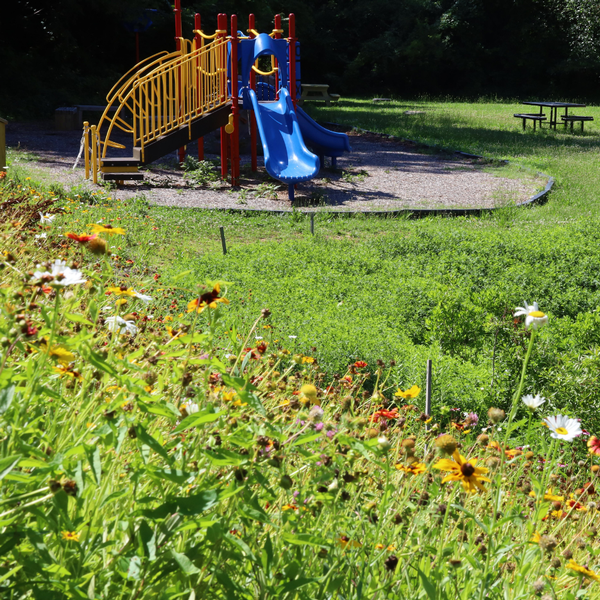
Both Camp Wildcat and my summer class were amazing. I don’t usually look forward to summer camps, but Camp Wildcat made me look forward to waking up and going to camp. —Siena Elementary Student
When the days are cold and the school year is in full swing, summer might feel like a long time away. But a successful summer plan starts in the winter. Parents with elementary and middle school–aged students might be wondering how summer school or camp can be beneficial.
Provided that there is the right balance of structure, recreation, and flexibility, summer academic programs and camps help students in terms of their academic performance and social–emotional wellness.
Benefits of Summer Academic Programs and Camps
Here are four keys for students to have a successful summer experience in summer school and/or a school-sponsored camp:
1. Summer academic programs give students a test drive of the school.
Learning about a new school over the summer can be a great trial run for students before the year starts. Maybe the new building is bigger or harder to navigate than a student’s old school, or classes use technology more regularly than students are used to. Or, a student just needs some extra time to get oriented to a new learning environment and school community.
Whether it’s one or all of these, think of summer school as a dress rehearsal for incoming students to start learning the tools, technology, and other systems that could be part of the norm at the new school. This is especially important for students with language-based learning differences, because they might want to start developing the accommodations and self-advocacy practices that a school like Siena has integrated into their curriculum, including our multisensory strategies.
As a Siena summer school teacher notes, “It’s great for new students to be around other new students before they’re around returning students once the school year starts. This makes the transition easier for new students because they’ve experienced a new school with their peers first.” Meeting some students and teachers over the summer gives incoming students a degree of familiarity with the community that will be such an important part of their daily lives once the year starts.
2. Summer academic programs help assess students' learning needs.
When students take summer classes, their teachers can start to identify their individual learning styles and executive functioning skills; this helps teachers develop learning profiles for their students to prepare for the coming year.
“Our summer classrooms provide the same individualized and research-based multisensory learning environments as during the regular school year,” notes Carolyn Bottelier, Science Department Chair and Director of Summer Programs. “Siena students can get help from teachers in a pressure-free environment to complete assigned summer work.”
Research shows that a summer academic program helps with retention, especially for students with dyslexia or other language-based learning differences. For Dr. Sally Shaywitz of the Yale Center for Dyslexia & Creativity, “If a child has been practicing a given set of words and word families during the school year, representatives of the word are beginning to find a permanent home within the [brain’s] word form area.” (See the article that quotes Shaywitz here.)
Students with dyslexia typically need more time and repetition to effectively store information within the automatic reading system; summer programs provide that needed time and repetition in a flexible, personalized environment.
3. Summer camps and academic programs support social and emotional wellness.
I was nervous at first, but the teachers and students were really nice. They made me feel like I was part of the school community. —Siena Elementary Student
Attending a summer program or summer camp as an incoming student could be especially good for anxious learners to get a microexperience of the school, their peers, and teachers. Programs and camps allow students to socialize and form community bonds to lead them into the new school year, in addition to being gradually introduced to the school’s teaching methods and overall learning environment.
As the Yale Center for Dyslexia and Creativity article notes about camps in particular, “Summer camps can also be important for dyslexic students who have deep interests that get sidelined or shortchanged because of academic demands during the school year,” which succeeds in “connecting [them] with other students who share [their] learning profile.”
4. Summer camps and academic programs prepare students for the school year.
“The key to a successful summer for students with dyslexia,” reiterates Director of Summer Programs Carolyn Bottelier, “is balance. Summer at Siena provides that balance for students.” Providing opportunities for both exploration of strengths and interests, as well as providing academic support, helps create a well-rounded summer.
An added benefit of attending summer programs or camps is getting students more comfortable navigating the school, learning the teachers’ expectations, or allowing for exposure to the school to see if it is a good fit for the student and if they will thrive in that setting.
Regardless of whether a student will attend the school hosting the summer program or return to another school, summer academic programs give them community connections, content knowledge, and awareness of their study skills and executive functioning needs. A summer program or camp could also highlight areas of improvement academically or social–emotionally for students as the new year approaches.
Summer downtime after a long school year is important, but so too is (some) summer work time to keep students’ skills sharp and—particularly for students with dyslexia—word retention active.
Need more resources for parents and community? See The Siena School blog for ideas on ensuring a successful school visit or how summer academics or tutoring can each be beneficial.
Resources for Students with Learning Differences
- Learn more here about Siena’s summer programs at its Silver Spring and Northern Virginia campuses.
- Siena Tutors provides individual instruction with experienced teachers to students throughout the United States in grades 3-12. Reading Rockets also has good information for finding a tutor for children with dyslexia.
- Education Consultant Ann Dolin’s website and YouTube Channel offer more resources and tips for avoiding the summer slide.
- LD Online and the Atlantic Seaboard Dyslexia Education Center (ASDEC) have a wealth of resources for families navigating academics and tutoring needs.
It’s Time To Be Social Again: Are Young People Ready?

With more tweens and teens getting the COVID vaccine, opportunities for social engagement are increasing. While many are looking forward to this return to normalcy as summer begins, many others are understandably feeling anxious about socializing after 15-plus months of limited social interaction.
Here are some tips for adults to help our tweens and teens navigate this reemergence while also caring for their social and emotional health.
Acknowledge the Issue
Engaging with others can feel hard when you’re out of practice; remember, also, that some teens may be nervous around germs and getting sick. Adults, validate your teens’ feelings around these feelings of worry; even share your own hesitations. Once you have validated these feelings, help the teen and/or tween in your life think about ways they’ve successfully coped with similar worries in the past.
We always want to encourage this reengagement with social activities (even on a small scale) as prolonged absence from socializing can lead to avoidance, which can lead to more pronounced worry.
This recent blog post from Screenagers has some examples and conversation starters for easing everyone back into social interactions this summer and fall. “We...should be applying scaffolding and can experiment with trying to help in different ways,” Dr. Delaney Ruston writes in the post. “The type of help will vary depending on our kids’ ages and situations, but I want to make sure we are all aware that there is a role for our social engineering at times.”
To begin guiding these social interactions, it may be helpful for parents to make a list of social opportunities that feel comfortable at first, such as outdoor-only activities, and add to that list as they (and you) get more comfortable.
Start Small
Big group activities may be too overwhelming at first, so it is perfectly acceptable to start small. Invite a small group of people (or even one or two peers for a social outing) and keep the time short to ensure that your teen/tween feels comfortable. Parents could talk with their teen/tween after the small social outing to assess what worked, what might not have, and what could work for a future outing.
Have a Purpose
A get-together with no purpose may be too open-ended and can lead to more anxiety. Instead, help your teen find a shared purpose while socializing. Some ideas for outdoor or indoor activities include:
- Walking to a store
- Baking/cooking
- Service learning/volunteering
- Playing a game (tennis, board game, etc.)
- Watching a movie
- Enjoying a meal together in an outdoor picnic
- Hiking
- Biking
- A sporting event
Have a Start and End Time
Establishing a start and end time creates structure, which can assist with teens’ comfort levels. Check in when planning an event and ask them how long seems reasonable. Many people may feel emotionally drained with long periods of socializing at first. Parents and/or teens can always increase the duration of activities as time goes by.
Get Input
Solicit input from all parties. When teens are excited about an activity, it will help ease some worry and give them something to look forward to.
Practice
Just like with any skill, practicing our social skills is important. If your teen is open to it, work on conversation starters. Discuss a recent social situation you were involved in and go over how it went, what went well, and what was awkward. The more we normalize awkwardness in social situations, the more comfortable we all become; it is normal!
As we slowly ease back to bigger groups and more social opportunities, you should see your tween’s or teen’s comfort level increase. If you are concerned that they are isolating themselves or seem overly anxious, it may be helpful to reach out to a therapist to practice these skills. Here are some resources that may help you as you navigate finding a therapist:
- Child Mind Institute/Social Anxiety
- Child Mind Institute/Who Can Help with Diagnosis
- Inclusive Therapists
- Find A Therapist: Psychology Today
What we have seen over this last year is that our teens and tweens are resilient and flexible and, given time and practice, these social skills will reemerge.
See The Siena School blog for more posts about social and emotional health, including some lessons in self-care and tips for returning to in-person school.

